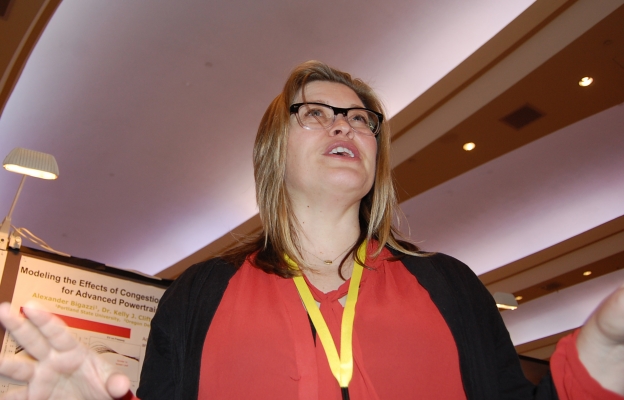News from TRB: Making trip-generation models work for urban transportation

Planners looking to develop an dense mix of urban land uses often face a dilemma: they’re using trip-generation models that undercount the very trips on bicycle and foot that the planners encourage while paving the way for more driving.
Portland State University Associate Professor Kelly Clifton dove into the topic Monday, presenting a paper at the Transportation Research Board annual meeting in Washington D.C. Kristina Currans of PSU, April Cutter of Metro, and Robert Schneider of the University of California Berkeley are coauthors.
Clifton and other panelists agreed that the Institute of Transportation Engineers’ trip generation rates don’t adequately reflect actual trips in an urban area with multiple land uses and transportation modes. They differed on the remedy, however.
Presenting another paper, Associate Professor Kevan Shafizadeh of California State University Sacramento, evaluated and tested several complex methods, finding that none truly suits smart-growth development projects. However, Shafizadeh and his team found that every method tested does a better job at predicting the number of trips generated than the ITE rates.
We need to predict trips better, Clifton said, but perhaps a simpler solution exists. She acknowledged Shafizadeh’s conclusions that each alternative also had deficiencies in certain applications, and suggested that the ITE rates could be tweaked instead of scrapped entirely.
“It’s a Band-Aid to temporarily adjust (the rates) until we come up with something better,” Clifton said.
To be fair to ITE, the trip generation rates never were intended for downtown settings served by public transportation, Clifton wrote in the paper. Instead, the handbook recommends that analysts set local rates for urban areas by collecting local data.
That, of course, takes more time and money than simply using an inaccurate method, as many agencies have done. Clifton’s “Band-Aid” would adjust the rates to better fit other contexts.
Using the suburban-slanted ITE trip-generation rates can derail many urban planning objectives, Clifton said, by overestimating vehicle trips. And that means making way for more cars: widening roads, adding parking and addressing congestion when none of those approaches may be warranted or wanted.
An adjustment can address those concerns during a transition to a better system, Clifton said, recognizing that agencies are hesitant to abandon ITE rates for something new and unfamiliar.
As Sam Zimbabwe with the District of Columbia Department of Transportation said Monday, even unreal numbers create political realities for residents and decision makers, realities the officials need to address.
The paper is “Context-Based Approach for Adjusting Institute of Transportation Engineers Trip Generation Rates.”
